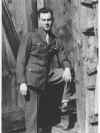
George Oakley Totten III
at MIS Language School, Ann Arbor, Michigan, 1943
Born in Washington, D.C. in 1922, son of an American architect of embassies and a Swedish sculptress, Totten’s interest in things Japanese was stimulated by a fabulous palace room built around the Shining Prince Genji theme by Okakura Tenshin in Tokyo in 1895 and presented to his mother as wedding gift by his father. This accounts in part for his interest in volunteering to study Japanese in the Army in 1942.
Leaving Columbia as a junior, he entered the MISLS at the University of Michigan and a year later Camp Savage. As described in his narrative, Totten served as one of two officers of a Japanese language detachment assigned to the 31st Division, first participating in the Mindanao landing; and then assisting at Davao in the postwar repatriation of Japanese POWs and Philippine Nisei. He was very concerned about their fate and that of their Filipina wives in just-defeated Japan. After that he served in the Occupation.
Returning to Columbia after his discharge, he received his AB and AM; and later his MA and PhD from Yale. Occupation duty had aroused his interest in the Japanese political movements which had opposed their country's drift into a war of aggression abroad. Discovering secret files of Japan's prewar Home Ministry that the U.S. had confiscated, he eventually wrote The Social Democratic Movement in Prewar Japan (Yale University Press: 1966) based on these files; collaborated on writing Socialist Parties in Postwar Japan ~ale University Press: 1966) and editing Democracy in Prewar Japan: Groundwork or Facade? (D.C. Heath & Co.: 1965); and contributed to Sources of Japanese Tradition (Columbia University Press: 1958). Later he collaborated on public policy books, such as The Whaling Issue in U S. Japan Relations (Westview Press: 1978) and Japan and the New Ocean Regime (Westview Press: 1984). He has published extensively on China and Korea, having also studied their languages. His latest publication is Community in Crisis: The Korean American Community After the Los Angeles Civil Unrest of April 1992 (Center for Multiethnic and Transnational Studies, University of Southern California: 1994).
After teaching on the East Coast, he joined the Political Science Department at the University of Southern California, 1965-1992, serving as department chair and director of various East Asian centers both at USC and the University of Stockholm, where he spent a number of years on leave from his university (he has been fluent in Swedish since childhood). He has thus contributed to mutual understanding between America and Europe on the one hand, and Japan, China (and Taiwan), and Korea (both North and South) on the other. He has been politically active for international peace and understanding.